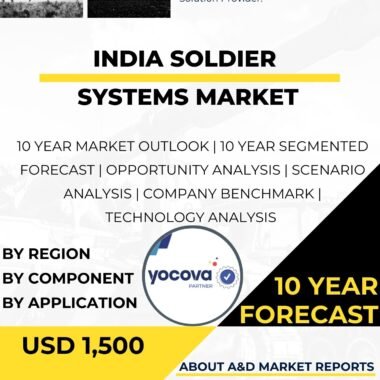Description
The Soldier Systems market in Malaysia has witnessed significant growth and development in recent years, reflecting the country’s commitment to enhancing its armed forces’ capabilities, modernizing its military equipment, and ensuring the safety and effectiveness of its soldiers on the battlefield. Soldier Systems refer to a wide range of individual equipment, clothing, and protective gear designed to enhance the combat performance, survivability, and situational awareness of military personnel. The adoption of advanced Soldier Systems enables Malaysia to establish a modern and well-equipped fighting force, contributing to the country’s overall defense preparedness and national security.
As a nation with strategic geopolitical importance in Southeast Asia, Malaysia faces diverse security challenges, including potential threats from hostile forces, counterterrorism operations, and regional stability concerns. The use of advanced Soldier Systems enables Malaysia to equip its armed forces with state-of-the-art gear, enhancing their ability to respond to various threats and maintain operational readiness.
The Soldier Systems market in Malaysia has witnessed significant technological advancements. Modern Soldier Systems incorporate advanced materials, ergonomic designs, and cutting-edge technologies to optimize soldier performance and comfort. These advancements have improved the mobility, protection, and lethality of military personnel, making them more effective and resilient in challenging operational environments.
Moreover, Soldier Systems play a pivotal role in the Malaysian Armed Forces’ operational readiness. The Malaysian Army, Royal Malaysian Navy, and Royal Malaysian Air Force equip their personnel with advanced individual equipment, including body armor, helmets, load-carrying systems, and personal communication devices. These Soldier Systems enhance the soldiers’ survivability and mobility, ensuring they can carry out their missions effectively in different terrains and scenarios.
Additionally, Soldier Systems are crucial for enhancing the soldiers’ situational awareness and information sharing capabilities. Modern Soldier Systems may incorporate cutting-edge sensors, integrated communication systems, and tactical computing devices, allowing soldiers to receive real-time intelligence, communicate with their units, and access critical data on the battlefield.
Furthermore, the adoption of advanced Soldier Systems supports Malaysia’s commitment to enhancing its defense industrial base and fostering indigenous defense capabilities. The Malaysian government has shown interest in developing and manufacturing individual equipment and Soldier Systems through local research and development (R&D) initiatives and partnerships with global defense companies.
The Malaysian government has recognized the importance of international collaborations in acquiring and developing Soldier Systems technologies. Partnerships with leading global defense contractors and Soldier Systems manufacturers have facilitated access to cutting-edge gear and expertise. These collaborations have enabled technology transfer and capacity building, contributing to the growth of Malaysia’s domestic Soldier Systems capabilities.
While the Soldier Systems market in Malaysia shows promise, it is not without challenges. One of the primary hurdles is the high cost of acquiring and maintaining advanced Soldier Systems. These sophisticated individual equipment and gear require significant investment in research, development, procurement, training, and logistical support. Budget constraints may impact the pace and scale of Soldier Systems acquisition and modernization efforts.
Moreover, ensuring the proper training and maintenance of Soldier Systems are essential for maximizing their benefits. The Malaysian Armed Forces must invest in continuous training and education to ensure their personnel are familiar with the Soldier Systems’ features and functionalities. Additionally, proper maintenance and regular servicing are critical to ensuring the durability and reliability of the gear.
Additionally, addressing soldier feedback and incorporating user-centric design in the development of Soldier Systems is crucial. Understanding the soldiers’ needs and experiences on the ground will lead to the development of more effective and user-friendly equipment, increasing the soldiers’ comfort and overall combat performance.
Looking ahead, the Soldier Systems market in Malaysia is poised for further growth. The government’s commitment to enhancing its defense capabilities, modernizing its military equipment, and investing in advanced individual equipment will drive continued investments in Soldier Systems. As Soldier Systems technologies continue to evolve and demonstrate their effectiveness, they are likely to play an increasingly pivotal role in Malaysia’s defense and national security strategy.
Moreover, Malaysia’s participation in regional security collaborations and joint military exercises will likely influence its Soldier Systems requirements. As the country seeks to strengthen its position as a key player in regional defense and security cooperation, the demand for advanced Soldier Systems with interoperability and compatibility with allied forces will increase.
In conclusion, the Soldier Systems market in Malaysia has experienced significant growth and progress. The government’s focus on enhancing its defense capabilities, modernizing its military equipment, and investing in advanced individual equipment has paved the way for the integration of modern Soldier Systems into its defense infrastructure. International collaborations and domestic research efforts have positioned Malaysia as a participant in the global Soldier Systems technology landscape.
However, challenges related to budget constraints, technology development, training, user-centric design, and engineering expertise must be addressed proactively to sustain and enhance the growth of the Soldier Systems market in the years to come. By maintaining a modern and well-equipped fighting force, Malaysia can effectively enhance its defense preparedness, protect its soldiers, and ensure the safety and security of its nation.




